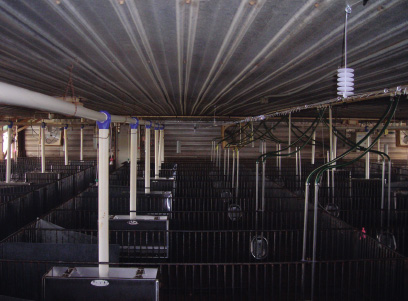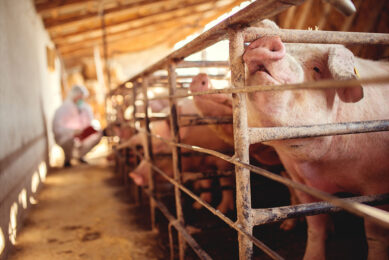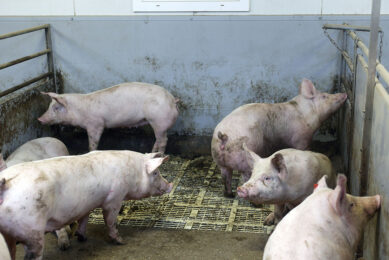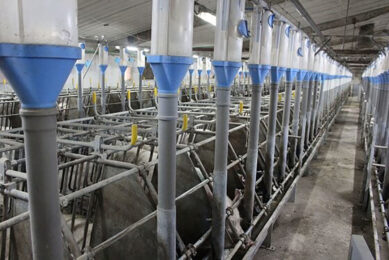Murphy-Brown going for cleaner air using ionisation

Negatively charged ions may soon be clearing the air of dust and other harmful emissions such as ammonia and hydrogen sulfide in your hog and poultry facilities. Electrostatic particle ionisation (EPI) is the key word for this novel environmental technology.
For some reason, an empty tent attracted a lot of attention at the last edition of the World Pork Expo, in Des Moines, Iowa. It was set up in the middle of the Varied Industries Building – and from the outside it seemed that inside there were only interested visitors. What was going on?
What had to be shown is invisible to the eye, explained John Baumgartner, occupying the adjacent booth and president of Baumgartner Environics (BEI), inviting guests to come inside. He then activated a system which created a tingling effect on the face, hands and head. “An emission of negative ions,” nodded Baumgartner – “a way of cleaning the air in pig and poultry barns.” Only to add that Murphy-Brown, Smithfield’s pig production division, has executed a contract to put so-called Electrostatic Particle Ionisation (EPI) systems in nursery facilities with 655,000 spaces and in wean-to-finish facilities for 864,000 spaces in their western US operations. What is the idea?
Some history
The BEI company, headquartered in Olivia, Minnesota, developed, patented and markets EPI systems in the United States and elsewhere – but the technology goes way back.
Ionisation was first used in 1842 and commercialised in 1907 to prevent sulfuric acid mist and lead oxide fumes from affecting a downwind California vineyard. Today, perhaps the most successful industrial use of electrostatic precipitation is to reduce the ash loads released into the environment by coal-fired power plants. This industry uses electrostatic precipitation as an end-of-pipe solution, i.e., after combustion, with more than 95% of the ash being removed from exhaust gas before it escapes into the air.
Much the same happens in swine and poultry barns. Realising the hazards of dust inhalation, United States Department of Agriculture scientists in the 1980s started focusing on tests to improve air quality. Dr Dwaine Bundy, emeritus professor of Agricultural and Biosystems Engineering, and agricultural engineer Dr Michael Veenhuizen conducted a study in 1987 that achieved 90% simulated dust reduction with electrostatic precipitation technology. However interest in electrostatic precipitation technology never really gained ground. The potential of production gains in real dollars through dust reduction was overlooked entirely.
All the more surprising, in view of additional research by USDA scientists showing gas molecules such as ammonia and hydrogen sulfide adsorbed onto dust from the air of swine barns contributed to respiratory disease. The data indicated between 35% and 60% of swine raised in confinement suffer from pneumonia. It only follows that a reduction in dust has a net health benefit for the swine.
Capturing
Matthew Baumgartner, the company’s general manager, said: “The ions go to work capturing and holding particles onto interior surfaces. The net result is ventilation enhancement that results in faster gain and less mortality.” As indicated, the technology has met criteria laid out by Murphy-Brown. In initial trials, EPI units were installed in two, 2,000 head production nurseries and tested for five turns. A total of approximately 44,000 nursery pigs ‘tested’ the technology. The results were positive: average daily gain increased 12.2%, average weights increased by 9.3% and mortalities were reduced by 26.1%.
Besides these production gains, Murphy-Brown also checked multiple dust size levels, ammonia, odour and hydrogen sulfide in these barns. Their PhD researchers measured a 57.7% reduction in particulate matter of 10-micron size; a 47.8% reduction in PM 2.5; a 43.1% reduction in PM 0.05. The EPI barns had a 55% reduction in ammonia versus the control barns; a 58.6% reduction in hydrogen sulfide and an 18.9% reduction in odour.
Trials
In these trials, the EPI systems were in rooms approximately 18 x 30 m with one room cross ventilated; the other with diffused ventilation drawn through holes in a plastic ceiling. Adjacent and identical nursery rooms were used as controls. All other controllable parameters such as swine genetics, source sow farm, etc., were held constant. Differences due to barn and cycle were included in the statistical model.
The three main components of the EPI system are power supply, corona points and insulators. Corona points are barely noticeable ‘sharpened points’ from which negative ions jump into the air; grabbing particles, clumping them into larger chunks and holding them on surfaces.
Bob Coffelt, business development manager of the Murphy-Brown Western Division commented: “The strength of the probability out of our testing convinced us fairly quickly that this appears to be an innovation well worth our time. When we first looked at it, the system appeared to be fairly unorthodox. But the results speak for the system. Pigs simply do better.”Low maintenance and the unobtrusiveness of these EPI systems is an additional value point, said Coffelt. “It tends to challenge one’s concept of the improbable values of dust suspension and odour issues. The sensory impact would lead one to believe that odours were lower in rooms equipped with EPI.”
Tests in broiler production Not only in pig production have positive test results been acquired. Broiler production improvements were noted in an independent Canadian study conducted by the Sustainable Poultry Farming Group in conjunction with University of British Columbia in Vancouver. In addition, Dutch research at Wageningen University and Research Centre (WUR), showed in recent research (March 2011) that negative ionisation helped reduce PM10 (particulate matter 10 micron size) by almost 49%, with only a standard deviation of 2.3%. Effects on PM2.5 emissions were measured too, as well as on ammonia, odour, methane and nitrous oxide. Most criteria showed a reduction as well. |











